Live
- BJP slams Mehbooba Mufti for remark on Indus Water Treaty
- Global brokerage CLSA shifts ‘tactical allocation’ to India from China
- Istanbul nabs over 240 illegal migrants
- Haryana CM takes dig at Punjab counterpart on setting up of new legislative Assembly
- Avvatar India and Spartan Race Kick Off India’s Ultimate Fitness Challenge in Bengaluru
- CM Revanth Reddy Pays Tribute to Guru Nanak on His Birth Anniversary
- ‘Matka’ clears censor: run-time locked
- ‘Kubera’ first glimpse looks interesting
- It took me 20 years to reach Sahnkar sir’s ears: Thaman S
- Gaurav Bhatia slams Congress for promising freebies to infiltrators in Jharkhand
Just In

A \'laugh star\' - 3D-printed representation of sound waves generated from human laughter - created aboard the International Space Station (ISS) has become the first ever piece of art to be produced outside Earth.
A 'laugh star' - 3D-printed representation of sound waves generated from human laughter - created aboard the International Space Station (ISS) has become the first ever piece of art to be produced outside Earth.
The artwork was printed using the Additive Manufacturing Facility (AMF), a gravity independent 3D printer, which supports the daily operations of the ISS by producing parts, tools and assemblies, effectively eliminating the need to wait months for those to be launched from Earth.
The work was conceptualised by Israeli contemporary artist Eyal Gever, who is passionate about using art as a medium for social impact, that connect people from different backgrounds and nationalities.
While many artists such as Andy Warhol, Robert Rauschenberg and Damien Hirst have created works of art that have subsequently been sent to space, Gever's art work is the first to be produced in space through 3D printing technology.
Gever thought it fitting that the first ever piece of art created in space be laughter as it represents what humanity can achieve with positivity.
Similar to art, laughter is a human expression which is universally understood.
"We live in epic times, where continuous disruption and rapid change exists against a backdrop of extremely volatile cultural shifts constantly challenging our human conscience," said Gever.
"A Laugh Star floating in space, above all our heads, is my attempt to create a contemporary metaphor for the hanging 'Sword Of Damocles,' a reminder that the beauty of human-life is so fragile," he said.
The project #Laugh kicked off with the launch of a mobile app that recorded sounds of laughter from individuals and converted the sound waves into a digital 3D model, or "laugh star."
Users were then encouraged to view, listen to and vote on their favourite laugh star. Over 100,000 people from around the world created their own laugh stars.
The winner of the competition, Naughtia Jane Stanko of the US, had her laugh star 3D printed aboard the ISS.
"The earliest cave paintings were of human hands which were a way of proclaiming and celebrating the presence of humanity, #Laugh is the 21st century version of that - a mathematically-accurate encapsulation of human laughter, simply floating through space, waiting to be discovered," said Gever.
"It's important for the world to see that technology and art are not independent of one another," said Andrew Rush, President and CEO of Made In Space, which owns and operates the AMF.
"We've enjoyed being a part of this project, and hope that it communicates to the world that innovation and creativity are the driving forces behind humanity's future in space," said Rush.

© 2024 Hyderabad Media House Limited/The Hans India. All rights reserved. Powered by hocalwire.com







